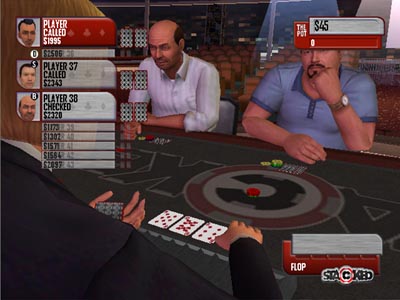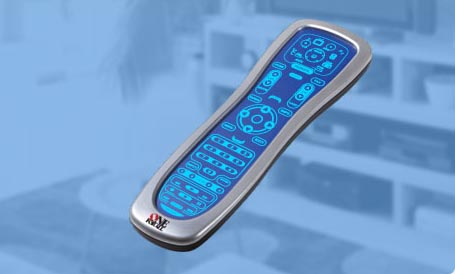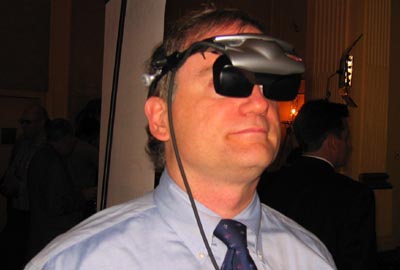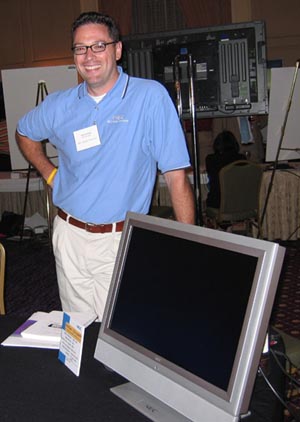Digital Life 2005 - Sneak Preview
By Chris Boylan
Get a Life
The
Digital Life trade show, scheduled for October 14-16, 2005 in New York City aims to bring vendors of digital technology together with consumers and press to visualize what is possible today and in the future through the miracles of modern technology.
Ziff Davis, the show host, offered a sneak preview to press and analysts on July 12th at the Roosevelt Hotel in Manhattan where a number of exhibitors assembled to show their wares, some of which were quite interesting.
[editor's note: coverage of the actual Digital Life 2005 show at Javits Center is now online here].

The geeks converge on the Digital Life press preview in New York City.
First up was a company called
Myelin Media who was showing off their upcoming Poker game "Stacked" for the XBOX, PS2 and PC platforms. The game has some unusual twists -- a.) it features lifelike animation of real-world Texas Hold'em players like Daniel Negreanu and Jennifer Harman and b.) it learns how to beat you. Yup, it has a built-in Artificial Intelligence engine so it can bluff with the best of 'em. You can play against the AI players, or jack into the net and play against your buddies online. Apparently Daniel himself will be playing online once this goes production (and when he does, he's the only one who can use that particular avatar). The game offers customizable avatars so you can make yourself as pretty (or as ugly) as you like or pick one of the included pro players as your virtual self. It even has "stacked" waitresses wandering around to take your virtual drink orders. One more reason to never leave the house. More info at
PlanetStacked.com.

Make yourself fat, skinny, bald or hairy. Be a woman or a man. It's up to you in Stacked. Oh and while you're at it, you might as well play some poker.
Universal Electronics was showing off their newest One For All Kameleon touch screen remotes, which feature "intelligent illumination" -- they only light up the features and keys that you need for each specific device. The new models range from the Kameleon 6 Hybrid ($49.99) a combined hard button/touch screen model, to the Kameleon 8 RF ($129.99) -- a pure touch-screen model that includes built-in RF functionality so you can use it to control a system in another room or equipment that's behind opaque cabinet doors.

The sleek One For All Kameleon 8 controls up to 8 devices and comes in both standard IR ($99.99) and IR/RF ($129.99) versions.
Like the Logitech Harmony remotes, most models in the Kameleon line can be easily configured to operate multiple devices at one time, e.g., volume up and down could operate your receiver, while the menu arrows operate your DVD player and an "aspect" button operates your HDTV. Unlike the Harmony, the remote codes are all built into the unit, so no PC or Internet connection is required for programming.
The Kameleon 8 RF looks promising -- it's among the least expensive RF-enabled universal remotes available; it even includes a built-in modem so you can upgrade it for new devices over a standard phone line. I snagged one at the show when the PR folks weren't looking and will be running it through its paces in a full review soon.
And even cooler than the sexy Kameleon remotes was the Z800 3D Visor ($899) from
eMagin. Intended primarily for use with 3D video games for the PC, the Z800 consists of an integrated visor with two high-resolution Organic Light-Emitting Diode (OLED) screens, high quality earbuds and a noise-canceling microphone. It can also be used as a private video monitor and headset to view DVD movies or any PC content on any desktop or laptop computer. It runs off a standard USB port, and presents the equivalent of a 105 inch screen viewed from 12 feet away. You can also replace the included ear bud headphones with your own to get the very best sound.

eMagin CEO Gary Jones models the Z800 visor.
With the 3D game "Half Life 2," the visor provided a realistic and immersive virtual reality gaming experience. Moving your head around tracks instantaneously (using built-in gyroscopes) so your view of the game changes accordingly -- look up: there's the ceiling; down: there's the floor. And as you turn your head to look left and right, the audio tracks your head movement as well, giving you an even more realistic experience. With devices like this, it's only a matter of time before 3D adult game titles start popping up. Holodeck XXX, here we come!
Across the aisle was
Pacific Digital showing off their new 8X10 "MemoryFrame" digital picture frame ($399) -- an LCD screen in a photo frame which displays up to 80 digital photos via its internal memory. Unlike earlier Pacific Digital models, the new unit promises Internet connectivity, even wireless Internet connectivity via the 802.11b protocol. Most other digital photo frames on the market actually
require Internet connectivity (usually via a standard phone line) so you can download photos to the frame via a specialized photo hosting service. The nice thing about that is that you can easily share photos with multiple recipients (e.g., buy frames for both sets of grandparents and post new pictures of Junior to a web site, which automatically sends the pictures to both frames). The drawback? A monthly fee to the service provider for every picture frame -- it's the gift that keeps on taking (unless you pay the fee for the recipient, which can get expensive).

Pacific Digital's Mike Hope poses with their 8X10 MemoryFrame, freshly loaded with pictures from his trip to New York City.
Pacific Digital's frames are different in that they allow you to load pictures directly onto the frame (up to 80 photos, using the built-in 64 MB memory), with a built in flash card reader that supports all of the major memory card formats. You can also plug most digital cameras in directly via a USB cable and transfer photos over this way if you prefer. So if you want to avoid the monthly fees, and you plan to load pictures directly onto the camera, then you are free to do so with the Pacific Digital frames.
When the new frames' Internet connectivity features become available, this will offer the best of both worlds -- standalone photo display capabilities of up to 80 photos (more if you keep the memory card plugged into the unit) plus internet photo sharing for those who want to share photos with other frames. We're planning to get one of these into the Big Picture Big Sound labs to test it out and will share the results with our readers when we do.
If you're a musician, or just play on one HDTV, you might be interested in
eJamming's new product and service, which allows musicians to jam with each other over the Internet using any midi-enabled devices. The eJamming software compensates for Internet connectivity delays, introducing its own slight delay into each musician's playback of their own performance so you hear what your fellow eJamming buddy hears, and all the parts are in sync, whether your eJamming buddies are across the hall or across the ocean. The full duplex software works over any high speed broadband connection, supports 16 channels plus full VOIP (voice connectivity) so you can chat while you jam. Beta testing is underway now so visit their web site if you'd like to help test and shape the product's development. The production version will be based on a subscription model ($19.95/month for unlimited eJamming) and is expected to be available in September, 2005.

eJamming's CEO, Gail Kantor.
On the "Big Picture" front was
Colorvision's SpyderTV ($269) -- a software package and electronic color meter that allows the home theater hobbyist to accurately calibrate his or her display to NTSC standards. To do the calibration, you attach the color meter to your LCD, plasma, RPTV or direct view monitor, run the software on your PC while you adjust settings such as brightness, contrast, color and tint until the color meter tells you that you've reached the optimal settings. Will it be as good as an ISF (Imaging Science Foundation) professional calibration? Probably not, since it does nothing with your display's service menu -- it relies on the user menus only -- but it's only $269 and you can use it yourself to get a good picture from all of the displays in your home (and your friends' homes, if you're so inclined). Of course, since the color meter mounts to the display, this will not work with front projection televisions but anything else goes.

ColorVision's SpyderTV allows home theater geeks to calibrate their own display devices accurately and easily.
And on the "Big Sound" front was Shure who were showing off their new E4c sound isolation earphones ($299). I listened to these and their big brothers, the E5c ($499). I actually preferred the less expensive models, at least on the iPod compressed MP3 source material. Like the Etymotic earphones, the Shures are designed to form a tight seal in the ear canal so they isolate you from the noise instead of using electronic noise cancellation technology to actively cancel out the noise (which can also interfere with the music). They're basically like earplugs, but with high quality little speakers inside. One thing I preferred over my reference Etymotic phones is that the Shures were much more comfortable plus the cord was considerably less microphonic than the Etymotic cord. With the Etymotic, touching the cord is a little like touching the tube of a stethoscope. The Shures exhibited this phenomenon too, but less noticeably.

Shure's perky spokesmodel, Ellen Mahon shows off her wares.
Across from Shure were the guys from
Peerflix - a new service that allows DVD owners to trade movies with each other for a flat 99 cent fee per title. Based on a rating system that ranks new releases and boxed sets as more valuable than older or less expensive editions, Peerflix allows you to trim your collection by trading unwanted DVDs to members who want them in exchange for Peerflix points. Then you can use your accumulated points to obtain DVDs that you want from other Peerflix members.
On the Peerflix web site, you post both a want list of titles you'd like, and a list of those you're willing to trade and you get matched with peers who want what you have or have what you want. To keep mailing expenses low (37 cents, paid by the sender), Peerflix recommends you send the DVD only (no jewelbox) in one of their DVD mailers. Only the disc recipient pays the $.99 fee to Peerflix and the sender earns points for the trade upon confirmation of receipt by the requester. The system also includes a sort of feedback system similar to eBay so you can report bad trades in the unlikely event you get sent a bad disc. According to Peerflix, they're up to "tens of thousands" or trades per month so there should be no shortage of titles you'll want.

NEC's Tim Dreyer was all smiles.
Last stop (for me) at this little soirée was at the
NEC booth where Tim Dreyer of NEC Display Solutions was exhibiting some fine looking LCD displays, one a computer monitor, and one an HDTV-enabled 23 inch widescreen model, the LCD2335WXM($999). The 23 inch unit sports a 25 microsecond response time (not quick enough for gaming, but fine for everything else) and a 500:1 contrast ratio. I don't know if it was the low lighting or the complimentary bar talking, but while I'm not usually a fan of LCD TVs, this one looked very nice, even from up close.
That's all for now, folks. Come to the Javits Center in New York City in October for more of the best in digital technology.
[editor's note: coverage of the actual Digital Life 2005 show at Javits Center is now online here].








